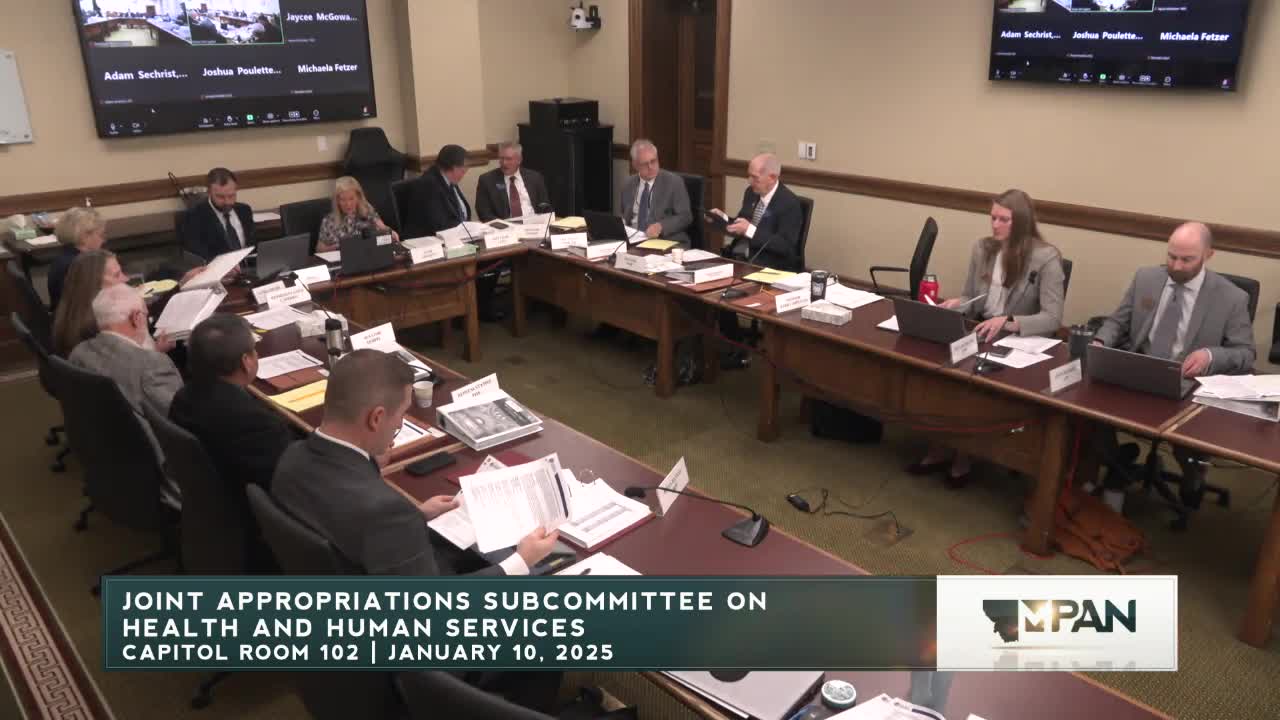DPHHS budget request asks for more state money as federal match falls; total HB2 request about $7 billion
January 10, 2025 | 2025 Legislature MT, Montana
This article was created by AI summarizing key points discussed. AI makes mistakes, so for full details and context, please refer to the video of the full meeting. Please report any errors so we can fix them. Report an error »

The Department of Public Health and Human Services asked the Section B appropriations subcommittee on Jan. 10 to consider a 2027 biennium House Bill 2 request that totals roughly $7 billion and includes substantial increases in state general fund as federal matching dollars decline.
Legislative Fiscal Division analyst Dr. Josh Poulet said the executive request is “3.3% lower than the 2025 budget” in total funds but increases general fund by double digits because of changes to the federal medical assistance percentage (FMAP). The request proposes a 12% general fund increase in state fiscal 2026 and about an 18% increase in 2027 compared with the 2025 base.
Why it matters: the FMAP formula reduces federal participation as Montana’s per‑capita income rises, so the state must make up a larger share of Medicaid and related program costs. The department also asked for large one‑time funding to shore up state run health care facilities and to continue several reform initiatives funded in the last session.
The LFD summary highlights drivers of the general fund increase: a projected FMAP decline, a roughly $70.3 million one‑time decision package to standardize wages and operations at state facilities, increased IT maintenance and SITSD service rates, and caseload adjustments in child and family services and Medicaid. In addition, the executive budget requests moving Supplemental Nutrition Assistance Program (SNAP) benefit authority to a statutory appropriation, which would remove about $345.1 million in federal authority from HB2 but does not reduce benefits.
Agency officials told the committee that many of the department’s large line items reflect federal benefit flows (Medicaid, SNAP, CHIP) and long‑term reform carries from the 2023 session. LFD staff emphasized the budget’s large federal share: benefits and claims make up the bulk of HB2 authority. The executive also included a package of decision items tied to the Behavioral Health System for Future Generations commission and continuing house bill 872 work.
The department said it will continue to develop IT projects funded through HB10, implement provider rate increases adopted in 2023, and pursue workforce and recruitment measures at state facilities. LFD and agency staff walked the subcommittee through statewide present‑law adjustments (personal services, fixed costs and SITSD charges) and noted a net budgeted reduction in position‑budgeted authority across the agency.
The subcommittee did not take action at the Jan. 10 meeting; members were briefed and asked staff for follow‑up materials, including division‑level historical spending visuals and contract inventories for procurement work.
Ending: Staff provided links and documents for members to review before division hearings begin next week; the subcommittee scheduled further consideration of Medicaid estimates, behavioral health, facilities and IT projects in upcoming meetings.
Legislative Fiscal Division analyst Dr. Josh Poulet said the executive request is “3.3% lower than the 2025 budget” in total funds but increases general fund by double digits because of changes to the federal medical assistance percentage (FMAP). The request proposes a 12% general fund increase in state fiscal 2026 and about an 18% increase in 2027 compared with the 2025 base.
Why it matters: the FMAP formula reduces federal participation as Montana’s per‑capita income rises, so the state must make up a larger share of Medicaid and related program costs. The department also asked for large one‑time funding to shore up state run health care facilities and to continue several reform initiatives funded in the last session.
The LFD summary highlights drivers of the general fund increase: a projected FMAP decline, a roughly $70.3 million one‑time decision package to standardize wages and operations at state facilities, increased IT maintenance and SITSD service rates, and caseload adjustments in child and family services and Medicaid. In addition, the executive budget requests moving Supplemental Nutrition Assistance Program (SNAP) benefit authority to a statutory appropriation, which would remove about $345.1 million in federal authority from HB2 but does not reduce benefits.
Agency officials told the committee that many of the department’s large line items reflect federal benefit flows (Medicaid, SNAP, CHIP) and long‑term reform carries from the 2023 session. LFD staff emphasized the budget’s large federal share: benefits and claims make up the bulk of HB2 authority. The executive also included a package of decision items tied to the Behavioral Health System for Future Generations commission and continuing house bill 872 work.
The department said it will continue to develop IT projects funded through HB10, implement provider rate increases adopted in 2023, and pursue workforce and recruitment measures at state facilities. LFD and agency staff walked the subcommittee through statewide present‑law adjustments (personal services, fixed costs and SITSD charges) and noted a net budgeted reduction in position‑budgeted authority across the agency.
The subcommittee did not take action at the Jan. 10 meeting; members were briefed and asked staff for follow‑up materials, including division‑level historical spending visuals and contract inventories for procurement work.
Ending: Staff provided links and documents for members to review before division hearings begin next week; the subcommittee scheduled further consideration of Medicaid estimates, behavioral health, facilities and IT projects in upcoming meetings.
View full meeting
This article is based on a recent meeting—watch the full video and explore the complete transcript for deeper insights into the discussion.
View full meeting
